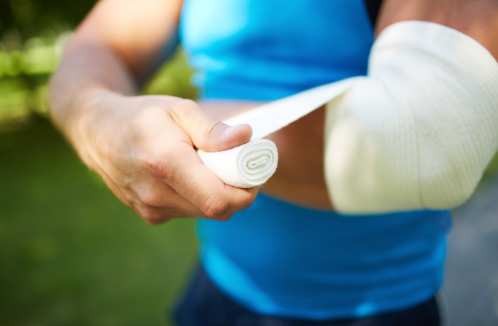Personal injury law covers more than auto accidents. Personal injury law is not something law students study. They study tort law, which deals with all wrongs people do to one another based on a violation of their unwritten legal obligations.
Potential clients don’t realize the breadth of personal injury cases that a law firm can handle. These are the ten types of injuries that a personal-injury law practice can help with:
Traffic accidents
Most car accidents are the cause of personal injury. Personal injury lawyers are able to handle many traffic accidents including pedestrian accidents and motorcycle accidents. If you were a passenger in an automobile, such as a bus, taxi or rideshare, and you are injured in a traffic accident, a personal injury lawyer may be able to represent you.
In all cases, the rule is that if someone causes an accident by driving negligently, their insurance will pay for the damages up to the policy limits. If a driver causes $50,000 damage in an accident and has only $30,000 automobile coverage, then the insurance company will pay $30,000, while the driver will have to pay $20,000.
As we have already mentioned, personal injury lawyers are able to handle any type of traffic accident case.
- Bicyclist or pedestrian: In Florida, nearly 8,000 automobile accidents resulted in the death of more than 500 pedestrians in 2008. The driver can be sued if a pedestrian or cyclist is hurt or killed by a driver.
- Motorcycle: According the Insurance Information Institute motorcycles are 27x more likely to be in an accident that results in death than trucks and cars. Motorcyclists can overlook motorcycles because they are more visible than trucks and cars. Motorcyclists are also exposed to the motorcycle. Motorcyclists are more susceptible to serious injuries. A motorcyclist accident lawyer may help the driver to get compensation for injuries and property damage if he or she collides with another motorcyclist.
- Commercial vehicles: Delivery vans and trucks are hard to maneuver, and can have blind spots. These vehicles are often in traffic for longer hours and travel more miles than any other vehicle. Because of the involvement by the general liability insurance company of the business, claims involving commercial vehicles may be treated differently than ordinary auto accidents.
Workplace Injury
Workers compensation insurance covers most injuries sustained on the job. Workers comp does not require you to prove negligence in order to be eligible for compensation. Workers comp is available in most states, even if your mistake caused your injury.
But, it is possible to not receive full compensation. You will need a Workers Comp lawyer to assist you with your workers comp claim. Some examples include:
- Pre-existing condition: Worker’s comp claims may be denied if your insurer believes that your injury was caused by your current job.
- Workers comp does not cover injuries that are the result of an accident or incident.
- Severity: Your workers compensation insurer might question the severity of your injuries or the treatment you need. The insurer might also question whether your injuries are exaggerated or faked.
Your employer must report your workplace injury to the workers compensation insurer in most states. Your claim is investigated by the insurer who determines whether you are entitled to compensation for lost wages and medical bills.
Workers are prohibited from suing employers for injuries sustained on the job if they have workers’ comp. Some states grant exceptions that allow workers to sue their employers for safety violations by their employer, and civil rights lawsuits for discriminatory acts. If your employer doesn’t provide safety equipment to certain employees because of their race you might still be able sue your employer.
Medical Malpractice
Medical malpractice cases are also handled by personal injury lawyers. If your doctor fails to provide you with medical care that is reasonable in the circumstances, and you suffer harm as a result of this, you might need to contact a lawyer for medical malpractice.
Here are some examples of medical malpractice:
- Diagnosis errors are errors in diagnosing you. Medical malpractice can occur when a radiologist misses a lump in a mammogram, and as a consequence, your case of breast carcinoma is not diagnosed.
- Treatment errors: A medical provider who is negligent in their treatment of you is deemed to have made a mistake. Examples include operating on the wrong limb or prescribing medication that you are allergic to.
- Communication mistakes: Your medical provider should fully discuss all of your options with you. You may be able sue a medical provider if they fail to disclose a side effect or obvious risk.
Because most medical professionals have medical malpractice insurance, medical malpractice cases are very similar to personal injury cases. Any claim against a medical provider will be referred to the malpractice insurance company for investigation. Many cases can be resolved by medical malpractice lawyers without going to trial. They will negotiate a settlement with the insurance company. If the insurer refuses to work with you, you could end up in court.
Slip-and-fall Accidents
Premises liability is another area of expertise for personal injury law practices. These cases are often referred to as “slip-and-fall” cases. Premises liability does not only cover injuries from slipping on grapes in grocery stores. These are some examples of premises liability cases personal injuries lawyers could handle:
- Slip and fall: This is a common type of premises liability case that personal injury lawyers deal with. Slip and fall is when someone is injured by a hazard that the property owner or manager should have known about. Slip and fall cases could be caused by a liquid spillage, broken railing or icy walkway.
- Poor lighting: When someone steps on something or collides with it, poor lighting can cause all sorts of injuries. Poor lighting can also lead to collisions or even criminal activity in parking lots and alleyways. You can sue if you can prove that the manager or property owner knew of the dangers posed by poor lighting and failed to correct it.
- Electric hazards: Tenants and guests can be seriously injured by exposed wires or miswired electrical fixtures. Unreasonable failure to correct electrical problems or warn victims could lead to a lawsuit.
Individuals and groups can bring premises liability cases against businesses such as apartments, stores, hotels, casinos, and private individuals. If you host a party in your yard and fail to warn guests about broken railings around your deck, they might be able to sue you.
Animal Attacks
A personal injury lawyer can help with animal bites and injuries. Personal injury attorneys file claims against the home owner’s insurance policies when a domestic animal causes harm to someone (e.g. a household pet).
Some states make it mandatory that pet owners are responsible for any injuries their pets cause. These states have a “strict liability” standard. To be compensated for an injury, one would need to prove that the pet caused it.
Pet owners are not responsible for injuries sustained by pets because of negligence in other states. To be held liable in these states, the pet owner must have knowledge of the pet’s dangerous behavior.
Many states consider non-domestic pets, like snakes, dangerous. Because owners can’t train these animals, they assume all risks of injury to the animal. The owner would normally pay for any injuries sustained by wild animals, regardless of whether they were aware of their danger.
Defective Products
The designer, manufacturer, or retailer of the product may be held responsible if a product causes injury to someone. Three theories can be used by a personal injury lawyer to determine product liability.
- Design defect: When a product is defective in design, it is considered a design defect. Unsafe use of a product due to a design defect is not possible. A product with a design defect could include nausea medication that causes birth defects, asbestos, or lawn darts.
- Manufacturing defect: A manufacturing defect is a product that was intended for safe use but made in a way that makes it dangerous. One of the most well-known examples is the Bridgestone tires, which auto accident attorneys found to have been improperly manufactured and the treads had separated. The defective tires caused a redesign of Ford Explorer and a recall for 6.5 million tires.
- Warning defect: A product that is unsafe to use or has adverse effects can be considered a warning defect. One example of a warning defect is the failure by tobacco companies to warn tobacco smokers about the harmful effects of smoking, despite being aware of these dangers.
Negligence
Even if the case does not fit into any other category, personal injury lawyers are capable of handling all cases involving negligence. Accident attorneys are able to handle any situation:
- One person has a duty to care for another: This can be due to a special relationship, or the normal responsibilities of neighbours or bystanders.
- The person violates the duty to care: Usually, the breach of a duty to care means that the person did not act in a reasonable way under the circumstances. A breach could be either an act (or an omission) or a failure to act.
- The victim sustained damage: This can include property damage, bodily injury or even death.
- The breach was the legal or factual cause of damage. The most common legal test for causation in law is whether the damage was foreseeable as a result of the negligent act, omission, or both.
A worker who does not secure the area before trimming a tree or accidentally drops a branch onto a pedestrian is an example of negligence. The worker’s employer would be responsible for the worker’s negligence. Its business liability insurer would cover the pedestrian’s medical costs and any consequential damages in the event of a personal injury claim.
Assault and Battery
Personal injury law covers both negligent and intentional acts. As an example, assault and battery can be defined as a deliberate act of touching another person. Here are some examples of assault:
- Fights: A fight is when one person strikes another. This applies regardless of whether the punch was intended to strike the victim, or accidentally struck him. This means that whoever a punch is thrown at, the victim commits battery.
- Sexual assault: Victims of sexual assault can file a personal injury suit against the perpetrator. This allows victims to seek damages for their injuries and consequential damages.
- Police abuse: A police officer who intends to injure or kill another person, even though the law does not require it, is committing an act of battery, false imprisonment, or restraint. These actions can be grounds for a lawsuit against police.
A lawsuit for intentional tort (e.g. battery) is better than a negligence suit because the plaintiff doesn’t need to prove the plaintiff was injured. The court assumes that damages have been suffered. Insurance policies seldom, if ever cover intentional acts. If a plaintiff sues drunk driver for battery or negligence in causing an accident, the auto insurance company would only cover the damages related to the negligence, and the driver would be responsible if any damages result from the battery.
Defamation
Personal injury lawyers aren’t just concerned with property and physical injuries. They are also able to handle cases involving injury to a person’s reputation. Defamation is a false public statement that brings a person’s reputation and character into disrepute.
Social media has given rise to defamation as a ground for lawsuits. To prove defamation, a plaintiff must show:
- False representation of facts: Opinions cannot be taken into consideration. They are only false statements.
- Publication: The statement must be published in writing or words by at least one person.
- Fault: The speaker should know that the statement is false, or they must make it without reasonable steps to verify its truth.
- Damage: The victim must sustain reputational damage as a result of the statement.
There are many types of personal injury cases. A personal injury law firm can assist anyone who has been injured by the actions of another.


